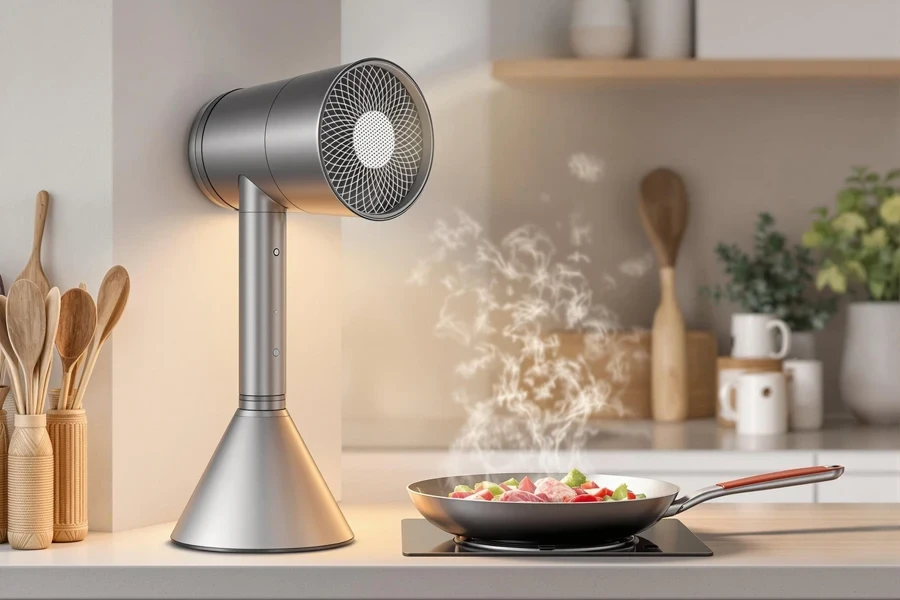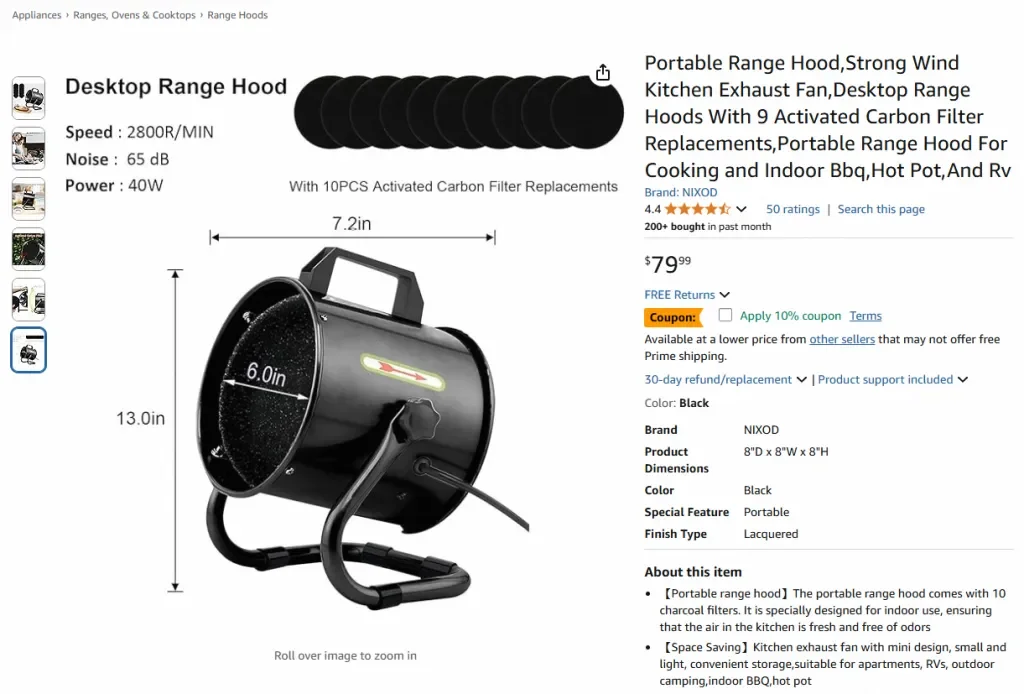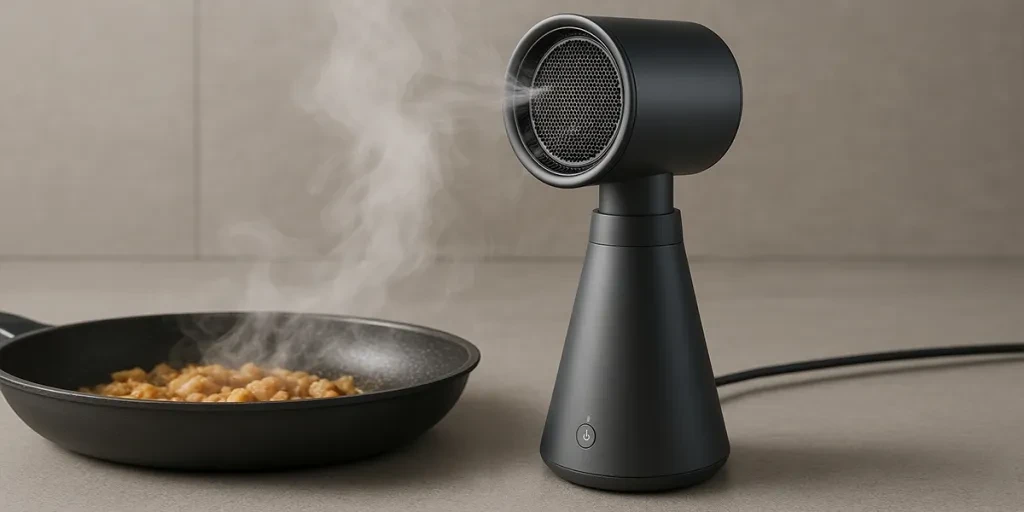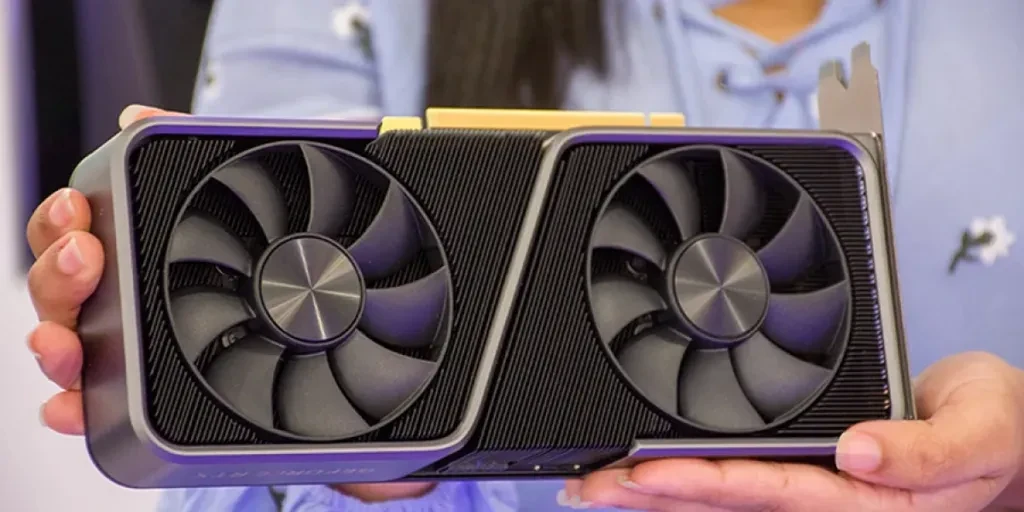Sometimes, kitchens get so thick with fumes and strong smells that breathing becomes almost impossible. While it sounds like a bad place to be, it’s the reality for many in busy cooking areas without range hoods. This appliance helps replace the bad air with something more breathable.
However, many think range hoods may be too big for their small or average-sized kitchens. While that’s true for traditional models, a better solution handles 90% of the problem: portable range hoods. Before adding portable range hoods to your inventory, keep reading to learn more about what to consider to stock the best options for your buyers in 2025.
Table of Contents
How big is the range hood market?
How portable range hoods compare to fixed models
1. Kitchen expansion
2. Kitchen installations
3. Cooking demonstrations and trade shows
4. Emergency backup ventilation
What to consider when choosing portable range hoods
1. Size and dimensions
2. Noise level
3. Filtration system
4. CFM ratings
The bottom line
How big is the range hood market?
Experts say the range hood market reached US$ 19.9 billion in 2023. They predict it will grow to US$ 34.39 billion by 2032 at a speedy 6.4% compound annual growth rate (CAGR). What’s increasing market profitability? With more people eating out, the food sector is growing, increasing the demand for range hoods to keep new kitchens safe and clean.
North America (especially the U.S.) held the largest market share (about 85.6%) in 2023. The region is the most profitable, thanks to the increasing demand for energy-efficient equipment. Asia-Pacific comes in second with a 50.7% market share and will grow at 6.6% CAGR over the forecast period.

How portable range hoods compare to fixed models
1. Kitchen expansion
Installing a fixed-range hood model needs a lot of work and investment. Consumers must get fans and ductwork, which can bump up their investment. However, portable range hoods are ventless, meaning they won’t have to deal with those extra installations. Even better, they are portable enough to move around a kitchen (small or otherwise).
2. Kitchen installations
Pop-up restaurants, events, and catering services usually use temporary kitchen spaces, so they won’t have the luxury of using a fixed range hood. Portable range hoods, with their small, desktop-fan-like design, solve this problem.
Users only have to move the device to where they want to use it and connect the mini range hood to a power source. This flexible solution allows mobile chefs to enjoy a clean, odor-free cooking area anywhere and anytime.

3. Cooking demonstrations and trade shows
Yet another area in which fixed-range hoods fall short is cooking showcases. Some professionals love doing cooking demonstrations or trade shows, but they can’t take their installed models with them for proper ventilation. However, they can take a portable range hood anywhere they need it.

Portable range hoods are popular because they quickly and efficiently create a controlled cooking environment. This allows chefs to focus their audience’s attention on the food’s delicious aroma and appearance, not the odor byproducts.
4. Emergency backup ventilation
Commercial kitchens are not immune to downtimes. And when it happens, it can be costly since their fixed hoods will stop filtering the cooking area. Portable range hoods are the perfect emergency backup ventilation, stepping in to tackle odors and fumes when the main ventilation system fails.

What to consider when choosing portable range hoods
1. Size and dimensions
Portable range hoods have one goal: be compact and easy enough for consumers to use near their cooking area or on a countertop. However, different models can have various sizes, though many often have a smaller size. For example, many popular models measure roughly 7 to 8 inches wide and deep and about 13 to 15 inches tall. This compact design ensures that even small kitchens in RVs or apartments can enjoy improved ventilation without going for a full installation.
2. Noise level
Range hoods can be noisy, but the noise level varies by model and fan speed. Quieter models are especially popular, particularly for people living in small spaces. For this reason, a range hood with noise levels under 65 dB is a great selling point for home kitchens since it’s about as quiet as a normal conversation.
However, some portable range hoods on their highest (or turbo) settings can easily pass 65 dB. Nevertheless, they still often stay within the acceptable noise range for home kitchens despite getting noticeably louder. To address this even better, businesses can offer portable range hoods with adjustable speed settings, allowing users to control airflow and noise to their preference.

3. Filtration system
Portable range hoods don’t use ducts to clear out grimy air. Instead, they clean the air using powerful filters. However, knowing that no universal option works for all situations is important. Different models can use other filters (or a mix of them), such as grease, charcoal, or HEPA filters, to handle various issues. Here’s a quick breakdown of each type.
| Filter type | Description |
| Charcoal filters | Charcoal filters are great at trapping odors and impurities. However, they need to be replaced every 3 to 6 months. |
| Grease filters | Grease filters from baffle or aluminum mesh can catch oily particles and clean the cooking area. Because many are reusable, they’re often more affordable and easier to maintain than charcoal filters. |
| HEPA filters | HEPA filters are for the more advanced models. They can remove even tiny particles, such as allergens and pollutants, making them ideal for people who want the highest air quality. |
Note: The best range hoods often include charcoal and grease filters, which can perform nearly as well as pricier HEPA filters. Just remember to check if these filters are dishwasher-safe for easy cleaning. If not, retailers must have replacement filters available for customers to buy.
4. CFM ratings
Businesses can determine the amount of air a portable range hood can handle by checking its CFM (cubic feet per minute) rating. This rating measures how much air the hood can pull in and how effectively it removes heat, smoke, and odors.

Generally, portable range hoods work with a 70- to 150-CFM range. Many models average around 100 to 110 CFM, like the popular RH180 model, which is rated at 106 CFM (approximately). Similar units often offer around 3 m3/min (roughly 106 CFM).
Note: Some models that handle more demanding cooking areas may push closer to 150 CFM, while more compact or energy-efficient designs may operate at lower ranges.
While higher CFM ratings usually mean better performance, they aren’t always required. The right CFM depends on the size of the kitchen and how often and intensely someone cooks.
The bottom line
Air quality is a big concern in small kitchens that can afford (space and budget) a ducted system. Since fixed installations are impossible, they can use portable range hoods that eliminate most of that hassle. But before businesses rush into this market, they must consider all the important factors, like size, filtration, noise levels, and CFM ratings. They’ll help ensure businesses can offer a model that fits their target consumer’s needs.




